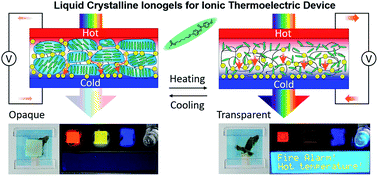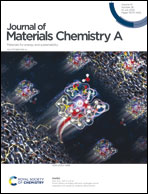Mesogenic polymer composites for temperature-programmable thermoelectric ionogels†
Abstract
Thermally programmable ionic thermoelectric (iTE) composites with optical tunability are explored as a transmittance tunable energy harvester to operate as a thermal sensor for low-grade heat sources. Liquid crystalline ionogels (LCIs) for iTE films are prepared via photopolymerization of ionic monomers (2-acrylamido-2-methyl-1-propanesulfonic acid) and hydrophobic nematic monomers (4-methoxyphenyl 4-((6-(acryloyloxy)hexyl)oxy)benzoate) in the presence of an ionic liquid. The LCI film shows reversible temperature programmability as well as fast transmittance switching at 65 °C, at which temperature the nematic-isotropic phase transition occurs. The LCI film for the iTE device shows a phase-controlled ionic Seebeck coefficient of −5.9 mV K−1 at 80% RH and produces a maximum thermoelectric power factor of 2.4 nW m−1 K−2. Taking advantage of the reversible thermoresponsiveness, the LCI iTE film is used to demonstrate a self-detectable and wireless fire alarm, which enables detection of elevated temperatures with the naked eye. Furthermore, the LCI iTE film is integrated as a thermal switch for an electrochromic window, a liquid crystal display, or a light-emitting diode to realize autonomous self-powered electronics that can be used to detect and view temperature changes in the environment.



 Please wait while we load your content...
Please wait while we load your content...